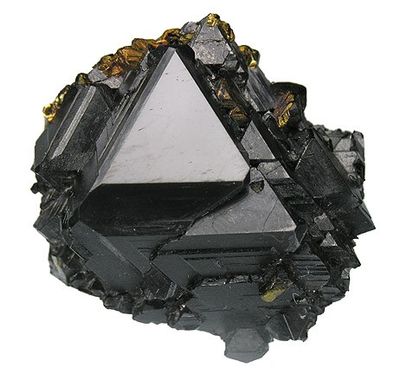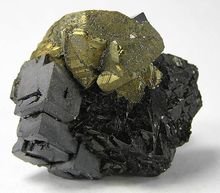Sphalerite
| Sphalerite | |
|---|---|
| Sphalerite specimen (size: 2.3 × 2.3 × 1.2 cm) from the Idarado Mine, Colorado, USA | |
| General and classification | |
| other names |
|
| chemical formula | ZnS |
|
Mineral class (and possibly department) |
Sulfides and sulfosalts |
|
System no. to Strunz and to Dana |
2.CB.05a ( 8th edition : II / B.01) 08/02/02/01 |
| Similar minerals | Chrysoberyl , cassiterite , rutile , magnetite , scheelite , sinhalite , tetrahedrite , topaz , zircon |
| Crystallographic Data | |
| Crystal system | cubic |
| Crystal class ; symbol | cubic-hexakistrahedral; 4 3 m |
| Space group | F 4 3 m (No. 216) |
| Lattice parameters | a = 5.41 Å |
| Formula units | Z = 4 |
| Frequent crystal faces | {110}, {311}, {3 1 1} |
| Twinning | {111}, {211} |
| Physical Properties | |
| Mohs hardness | 3.5 to 4 |
| Density (g / cm 3 ) | 3.9 (iron rich) to 4.2 (pure) |
| Cleavage | completely after {110} |
| Break ; Tenacity | clamshell; brittle |
| colour | colorless, red, green, yellow, brown to black due to the content of iron sulfide |
| Line color | yellowish to dark brown, never black |
| transparency | transparent to slightly translucent |
| shine | Diamond luster |
| Crystal optics | |
| Refractive indices | n α = 2.369 |
| Birefringence | none, since optically isotropic; occasionally stress-related, abnormal birefringence |
| Other properties | |
| Chemical behavior | soluble in concentrated hydrochloric acid |
Sphalerite , also known as zinc blende in mining terms, is a widespread mineral from the mineral class of " sulfides and sulfosalts " with the chemical composition α-ZnS and thus, chemically speaking, zinc sulfide .
Sphalerite crystallizes in the cubic crystal system and develops mostly tetrahedral and dodecahedral crystals , but also occurs in the form of fibrous to coarse mineral aggregates . In its pure form, sphalerite crystals would be colorless and transparent, but this can only be achieved with synthetically produced zinc sulfide. In nature, sphalerite almost always contains foreign substances ( non-formula elements or inclusions of other minerals) and is therefore mainly found in yellow and red or brown to black and rarely also in green. Its line color is also yellowish to dark brown, but never black.
With a Mohs hardness of 3.5 to 4, sphalerite is one of the medium-hard minerals that are easier to scratch with a pocket knife than the reference mineral fluorite (hardness 4) .
Etymology and history
The name sphalerite goes back to the Greek σφαλερός sphaleros (in German: insidious), since sphalerite has the specific weight and the luster of a metal ore, but no metal could be extracted from it until the 18th century. It was not recognized as a zinc mineral until 1735.
classification
Already in the now outdated 8th edition of the mineral classification according to Strunz , the sphalerite belonged to the mineral class of "sulfides and sulfosalts" and there to the department of "sulfides with M: S = 1: 1", where it was named after the "zinc blende series" with the system no. II / B.01 and the other members Coloradoite , Hawleyite , Metacinnabarite , Stilleit and Tiemannite .
In the last revised and updated Lapis mineral directory by Stefan Weiß in 2018 , which, out of consideration for private collectors and institutional collections, is still based on this classic system of Karl Hugo Strunz , the mineral was given the system and mineral number. II / C.01-10 . In the "Lapis system" this corresponds to the section "Sulphides with metal: S, Se, Te ≈ 1: 1", where Sphalerite together with Browneit , Coloradoite, Hawleyite, Ishiharaite , Metacinnabarite, Polhemusite , Rudashevskyite , Stilleit and Tiemannite form the " Sphalerite Group ".
The 9th edition of Strunz's mineral systematics , which has been in effect since 2001 and was updated by the International Mineralogical Association (IMA) until 2009, also classifies sphalerite in the category of "Sulphides with M: S = 1: 1 (and similar)". However, this is further subdivided according to the dominant cations in the compound, so that the mineral can be found in the sub-section "with zinc (Zn), iron (Fe), copper (Cu), silver (Ag) etc." according to its composition , where together with Coloradoite, Hawleyite, Metacinnabarite, Rudashevskyite, Stilleit and Tiemannite the "Sphalerite group" with the system no. 2.CB.05a forms.
The systematics of minerals according to Dana also assigns sphalerite to the class of "sulfides and sulfosalts" and there into the category of "sulfide minerals". Here he is also the namesake of the "Sphaleritgruppe" (isometric: F 4 3 m ) with the system no. 02.08.02 and the other members Stilleit, Metacinnabarite, Tiemannite, Coloradoite, Hawleyite and Rudashevskyite within the subsection " Sulphides - including selenides and tellurides - with the composition A m B n X p , with (m + n): p = 1: 1 ".
Crystal structure
Sphalerite crystallizes cubically in the space group F 4 3 m (space group no. 216) with the lattice parameter a = 5.41 Å and four formula units per unit cell .
The unit cell of sphalerite is formed by two nested, face-centered cubic (fcc) unit cells made of zinc and sulfur , which are shifted against each other by a quarter of their spatial diagonals. “ Zincblende structure ” is a fixed term for all binary crystals (e.g. GaAs ) with this spatial configuration. If the crystal consists of only one type of atom, the configuration corresponds to the diamond structure.
properties
When heated with oxygen ( roasting ), sphalerite breaks down into zinc oxide just like wurtzite . This decay was previously used, among other things, for qualitative zinc detection: sublimed zinc oxide is deposited on the carbon in front of the soldering tube. This is lemon yellow when hot (see also zinc suboxides ) and only takes on the typical white color of zinc oxide when it has cooled down.
Modifications and varieties
Sphalerite is the low temperature modification of zinc sulfide. The high-temperature modification is called wurtzite or β-ZnS .
Sphalerite comes in different color and shape varieties , some of which have individual names:
- Cleiophan is light green to yellowish (low iron and / or manganese content) or whitish in color
- As honey iris are clear, light refers to honey yellow crystals
- Rubinblende (English Ruby Jack ) is a red variety
- Marmatit and Christophit are iron-rich, black varieties
- Matrait is the name for dense, twinned Sphalerite
Sphalerite is also contained in the mineral mixture known as shell diaphragm, along with other sulfide minerals.
Education and Locations
Sphalerite forms either magmatically in pegmatite or hydrothermally . It is often associated with galena and other sulphide minerals, but also occurs as ore in limestone together with magnetite and pyrrhotite .
So far (as of 2015) over 20,000 sites are known worldwide, including lead mining in the Tyrolean Gurgltal in the 15th century (see also Knappenwelt Gurgltal ), in Freiberg (Germany), Madan in Bulgaria , Aomori in Japan , Dzhezkazgan in Kazakhstan , Cananea in Mexico , Dalnegorsk in the Russian Federation , Trepča in Serbia , Banská Štiavnica in Slovakia , Santander in Spain , Franklin / New Jersey , Big Four Mine / Colorado , Galena / Illinois and Joplin / Missouri in the United States .
use
With a zinc content of around sixty-seven percent and a relatively high cadmium content, sphalerite is the main source for industrial zinc and cadmium extraction. Larger mining sites are located in China , Australia and Canada . B. in Val-d'Or .
Sphalerite is rarely used as a gem because it is very fragile and sensitive to acids. In addition, it can easily be scratched due to its low hardness. With clear varieties of high quality, depending on the color and cut, there is a risk of confusion with more valuable gemstones such as chrysoberyl , topaz and tourmaline , with colorless varieties also with zircon and diamond .
Another important application, together with barite (barium sulfate), is the production of the white lithopone paint with a proportion of 15 to 60% sphalerite (zinc sulfide). By adding small amounts of copper and activating it with radium , zinc sulfide can also be used as a luminous paint.
See also
literature
- Petr Korbel, Milan Novák: Mineral Encyclopedia (= Villager Nature ). Nebel Verlag, Eggolsheim 2002, ISBN 978-3-89555-076-8 , p. 18, 26 .
- Martin Okrusch, Siegfried Matthes: Mineralogy. An introduction to special mineralogy, petrology and geology . 7th fully revised and updated edition. Springer Verlag, Berlin et al. 2005, ISBN 3-540-23812-3 , pp. 34 .
Web links
- Mineralienatlas: Sphalerit und Mineralienatlas: Mineralienportrait / Sphalerit (Wiki)
- Sphalerite search results. In: rruff.info. Database of Raman spectroscopy, X-ray diffraction and chemistry of minerals (RRUFF), accessed on November 21, 2019 .
- American-Mineralogist-Crystal-Structure-Database - Sphalerite. In: rruff.geo.arizona.edu. Retrieved November 21, 2019 .
Individual evidence
- ↑ David Barthelmy: Sphalerite Mineral Data. In: webmineral.com. Retrieved November 21, 2019 .
- ^ A b c Hugo Strunz , Ernest H. Nickel : Strunz Mineralogical Tables. Chemical-structural Mineral Classification System . 9th edition. E. Schweizerbart'sche Verlagbuchhandlung (Nägele and Obermiller), Stuttgart 2001, ISBN 3-510-65188-X , p. 76 (English).
- ↑ Sphalerite . In: John W. Anthony, Richard A. Bideaux, Kenneth W. Bladh, Monte C. Nichols (Eds.): Handbook of Mineralogy, Mineralogical Society of America . 2001 (English, handbookofmineralogy.org [PDF; 61 kB ; accessed on November 21, 2019]).
- ↑ a b Sphalerite. In: mindat.org. Hudson Institute of Mineralogy, accessed November 21, 2019 .
- ↑ Hans Lüschen: The names of the stones. The mineral kingdom in the mirror of language . 2nd Edition. Ott Verlag, Thun 1979, ISBN 3-7225-6265-1 , p. 191 (cover, zinc cover, sphalerite).
- ↑ Stefan Weiß: The large Lapis mineral directory. All minerals from A - Z and their properties. Status 03/2018 . 7th, completely revised and supplemented edition. Weise, Munich 2018, ISBN 978-3-921656-83-9 .
- ↑ Ernest H. Nickel, Monte C. Nichols: IMA / CNMNC List of Minerals 2009. (PDF 1703 kB) In: cnmnc.main.jp. IMA / CNMNC, January 2009, accessed November 21, 2019 .
- ↑ Cleiophane. In: mindat.org. Hudson Institute of Mineralogy, accessed November 21, 2019 .
- ↑ a b Hans Jürgen Rösler : Textbook of Mineralogy . 4th revised and expanded edition. German publishing house for basic industry (VEB), Leipzig 1987, ISBN 3-342-00288-3 , p. 310 .
- ^ Significant localities for Sphalerite. In: mindat.org. Hudson Institute of Mineralogy, accessed November 21, 2019 .
- ↑ Find location list for sphalerite in the Mineralienatlas and Mindat , accessed on November 21, 2019.
- ^ Leopold Rössler: Gemstone Knigge - Sphalerite. In: beyars.com. Retrieved November 21, 2019 .
- ^ Walter Schumann: Precious stones and gemstones. All kinds and varieties. 1900 unique pieces . 16th, revised edition. BLV Verlag, Munich 2014, ISBN 978-3-8354-1171-5 , pp. 216 .
- ^ Helmut Schrätze , Karl-Ludwig Weiner : Mineralogie. A textbook on a systematic basis . de Gruyter, Berlin; New York 1981, ISBN 3-11-006823-0 , pp. 153 .





